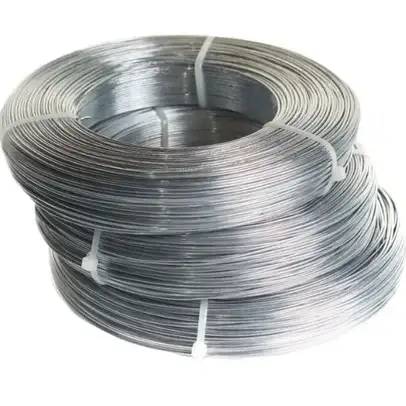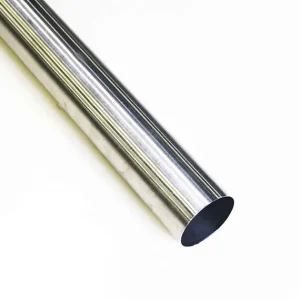Hastelloy C-276 wire (UNS N10276) is the benchmark nickel-molybdenum-chromium-tungsten alloy for the harshest corrosion environments — offering outstanding resistance to pitting, crevice corrosion, and stress-corrosion cracking across oxidizing and reducing media. For projects that demand long service life with minimal maintenance (chemical processing, pollution control, waste treatment, and oil & gas sour environments), C-276 wire is the pragmatic choice despite its premium price. MWAlloys supplies C-276 wire from China with 100% factory pricing, consistent inventory, and rapid dispatch for standard diameters.
What is Hastelloy C-276 wire?
Hastelloy C-276 is a wrought nickel-based alloy engineered to resist a wide spectrum of corrosive media. In wire form it is drawn, annealed, and supplied for welding filler, springs, resistance and precision components, and specialty fasteners. C-276’s chemistry intentionally balances molybdenum, chromium and tungsten to create a passive but durable surface film that performs in both oxidizing and reducing environments — a reason it is used when other nickel alloys fail.
Material identity and common designations
-
Trade name: Hastelloy® C-276 (brand names: Haynes® HASTELLOY® C-276, INCONEL® references exist for legacy literature).
-
UNS: N10276.
-
W. Nr / EN: 2.4819 (common European designation).
-
Typical product forms: wire, rod, bar, plate, sheet, tube. Wire specifically follows wire/rod standards such as ASTM B574 and ISO wire norms.
Chemical composition
Below is an industry-accepted composition summary for Hastelloy C-276 (UNS N10276). Values are expressed in weight percent (wt%). These ranges are standard in supplier datasheets and ASTM/ISO callouts; when ordering insist on mill certificates showing actual lot analysis.
| Element | Typical range (wt%) |
|---|---|
| Nickel (Ni) | Balance (remainder) |
| Molybdenum (Mo) | 15.0 – 17.0 |
| Chromium (Cr) | 14.5 – 16.5 |
| Tungsten (W) | 3.0 – 4.5 |
| Iron (Fe) | 4.0 – 7.0 |
| Cobalt (Co) | ≤ 2.50 |
| Manganese (Mn) | ≤ 1.00 |
| Vanadium (V) | ≤ 0.35 |
| Silicon (Si) | ≤ 0.08 |
| Carbon (C) | ≤ 0.010 |
| Phosphorus (P) | ≤ 0.04 |
| Sulfur (S) | ≤ 0.03 |
Notes: suppliers may publish “typical” (single-value) analyses and “specification” limits; always require the specification limits that match the purchase order.
Key mechanical & physical properties
The table below gives representative, commonly reported properties for annealed C-276 wire/rod used for engineering selection. Exact values depend on diameter, degree of cold-work and heat treatment.
| Property | Representative value (annealed) |
|---|---|
| Density | ~8.89 g/cm³ (0.321 lb/in³) |
| Elastic (Young’s) modulus | ~205 GPa (29.8 ×10³ ksi) |
| Shear modulus | ~79 GPa (11.4 ×10³ ksi) |
| Tensile strength (annealed wire) | typical 550–900 MPa depending on cold work and diameter (supplier datasheets vary). |
| Elongation (in 50 mm) | typically 30%+ for annealed wire, reduced by cold drawing. |
| Hardness (HB) | annealed low to moderate; increases with cold working. |
| Thermal conductivity | ~9.8 W/m·K |
| Coefficient of thermal expansion | ~12.8 µm/m·°C (20–300°C) |
Design implication: Because C-276 is relatively stiff and expensive, designers prefer minimal cross-section where corrosion allowance is gained by chemistry rather than thickness.
ASTM / ISO standards and common specifications for wire
Wire and rod for corrosion-resistant nickel alloys typically reference these standards (check product listing and mill test certificate for exact spec):
-
ASTM B574 / ASME SB574 — Nickel and Nickel Alloy Bars, Rods, and Wire (covers wire/rod manufacturing and chemical limits).
-
ASTM B575 / ASME SB575 — Nickel and Nickel Alloy Plate, Sheet, and Strip (relevant for other product forms).
-
AWS (welding filler) designations — filler wire specs for welding may reference AWS classifications.
-
ISO wire standards (ISO 9724/9725 family) and NACE/ISO 15156-3 (for sour service compatibility).
Wire specifications (typical supply): diameters from 0.15 mm to 10.0 mm (manufacturers differ), tolerances per ISO/ASTM wire tables, surface finish bright or oxided, spooled or coiled packaging. Buyers should specify mill certification (EN 10204 3.1 or equivalent) and traceability to heat number.
Why C-276 performs differently
C-276’s corrosion resistance emerges from composition synergy:
-
Molybdenum (Mo) and tungsten (W) strongly enhance resistance to pitting and crevice corrosion in chloride-bearing and reducing solutions.
-
Chromium (Cr) contributes to the passive film that fights oxidation and high-temperature attack.
-
Low carbon limits carbide precipitation at grain boundaries so welded zones retain corrosion resistance.
This unique mix makes C-276 effective in mixed, oxidizing and reducing chemistries — nitric acid with chlorides, strong organic acids, chlorine-containing streams, and many industrial waste streams. For aggressive oxidizing halogen media some alloys may be preferred, but C-276 remains the most versatile single choice for combined environments.
Fabrication, welding and handling recommendations
-
Welding: C-276 welds well using standard nickel-alloy wellding procedures (GTAW/TIG, SMAW, GMAW) with matched or appropriate filler alloys. Low carbon and balanced chemistry reduce susceptibility to weld-zone precipitation; yet pre- and post-weld procedures should follow supplier guidance. Typical welding parameters and filler designations are published by alloy makers.
-
Cold-drawing/annealing: Wire production includes cold drawing to size and intermediate anneals. Final anneal at elevated temperature restores ductility where specified. Heat treatment temperatures and cycles should follow mill recommendations — incorrect annealing can alter corrosion resistance.
-
Inspection: mill test certificates, chemical analysis, microstructure checks, tensile testing of representative samples, and surface quality inspection are industry norms. For sour or nuclear service, additional NDT and certification may be required.
Typical applications (wire form use cases)
-
Welding filler and brazing wire for chemical equipment repairs and construction.
-
Spring and mesh wire where corrosion resistance plus spring characteristics are needed.
-
Instrumentation and fasteners exposed to aggressive media.
-
Pollution control and flue-gas scrubbers, waste treatment lines and chlorinated acid service.
Case notes: in many chemical plants C-276 wire is chosen for weld repair rods and filler material for lining and piping because it keeps welded zones corrosion resistant without complex post-weld heat treatment.
Global price snapshot 2025
Prices for nickel-base specialty alloys change rapidly with raw material markets (nickel, molybdenum, tungsten) and supply chain constraints. The table below aggregates marketplace listings and market reports from 2024–2025 to give typical bulk price ranges for wire/coil (USD/kg). These are indicative; obtain firm quotes.
| Region / channel | Typical 2025 price range (USD/kg) | Notes / sources |
|---|---|---|
| China (direct manufacturers, small lots) | $30 – $60 / kg | China factory listings show competitive prices for small MOQ; quality varies — require MTC. |
| China (export platforms) | $35 – $70 / kg | Alibaba / Made-in-China listings for wire/coil. |
| India / South Asia | $45 – $95 / kg | Regional suppliers and local markup. |
| Europe (distributors) | $60 – $130 / kg | Higher due to logistics, duty, and distributor margins. |
| North America (distributors, small qty) | $70 – $140 / kg | Import, inventory and small order premiums. |
Procurement tip: larger lots and longer lead times generally reduce per-kg cost. Always require EN 10204 3.1 MTC or equivalent, and confirm actual alloy trace element limits. Market volatility in 2024–2025 means repeat price checks are essential before contract placement.
Sourcing, supply chain and why choose MWAlloys
MWAlloys is a China-based specialist supplier and manufacturer of nickel-base wires, including Hastelloy C-276 wire. Key selling points we provide:
-
Factory direct pricing (100% factory price): minimal trading margins — competitive per-kg pricing for both small and larger volumes.
-
Inventory & quick dispatch: standard diameters in stock for rapid shipment; custom diameters produced with short lead times.
-
Mill Test Certificates & traceability: EN/ASTM certificates, heat number traceability, and optional third-party testing on request.
-
Customization: bright/spooled/annealed conditions; packing to export standards.
Quality control & recommended tests on receipt
When receiving Hastelloy C-276 wire, perform or request the following checks:
-
Mill Test Certificate (MTC): EN 10204 3.1 or equivalent that lists chemical composition and mechanical test results.
-
Chemical analysis verification: spot check with OES or similar to confirm key elements (Mo, Cr, W, Ni balance).
-
Mechanical tests: tensile test or sampling if critical.
-
Surface & dimensional inspection: verify diameter tolerances, surface finish, and packaging.
-
Weldability trial: for welding filler applications, run a test weld to confirm filler behavior under your process parameters.
-
NACE/ISO compliance: for sour service, verify compliance to ISO 15156 / NACE MR0175 requirements where applicable.
Frequently asked questions
1. What is the exact chemical composition of Hastelloy C-276 wire?
Ranges are provided by producers; typical major values: Mo 15.0–17.0%, Cr 14.5–16.5%, W 3.0–4.5%, Fe 4–7%, C ≤0.010%, Ni balance. Request MTC for batch confirmation.
2. Which standards apply when I buy C-276 wire?
Common standards: ASTM B574 (wire/rod), ASTM B575/B575 for other forms; ISO wire standards and NACE/ISO 15156-3 for sour service. Confirm the standard on the PO.
3. Can C-276 be welded without special filler?
Welding is routinely performed with matched filler alloys; supplier welding data should be followed. Low carbon content helps retain corrosion resistance in the HAZ. Validate welding parameters with a sample weld.
4. Is Hastelloy C-276 suitable for chloride-bearing environments?
Yes — it resists pitting and crevice corrosion in many chloride environments better than many stainless steels and many Ni-Cr alloys. For highly oxidizing halogen environments, review compatibility charts.
5. What wire diameters are standard?
Manufacturers offer a wide range (commonly 0.15 mm to 10 mm); specify tolerance class and finish. Ask MWAlloys for stocked diameters and custom options.
6. How should C-276 wire be stored?
Dry, clean, and protected from contamination; avoid contact with carbon steel swarf. Retain MTC and packing information for traceability.
7. Typical delivery time?
From factory stock: days to 2 weeks depending on quantity. For custom draws or large orders: several weeks. MWAlloys emphasizes quick dispatch for stocked sizes.
8. Can C-276 be used in sour (H₂S) service?
C-276 can be compatible in many sour service scenarios but NACE/ISO 15156 guidance must be followed; material selection depends on pressure, temperature and chemistry.
9. How is price determined?
Price reflects alloy content, diameter, lot size, fabrication (annealed vs bright), and market metal prices (nickel, moly, tungsten). Larger volumes lower unit cost.
10. What documentation should be supplied with the wire?
Minimum: MTC with full chemical analysis, heat number, tensile test data (if required), and packaging list. For regulated projects, add material traceability, NDT reports, and third-party certificates.





